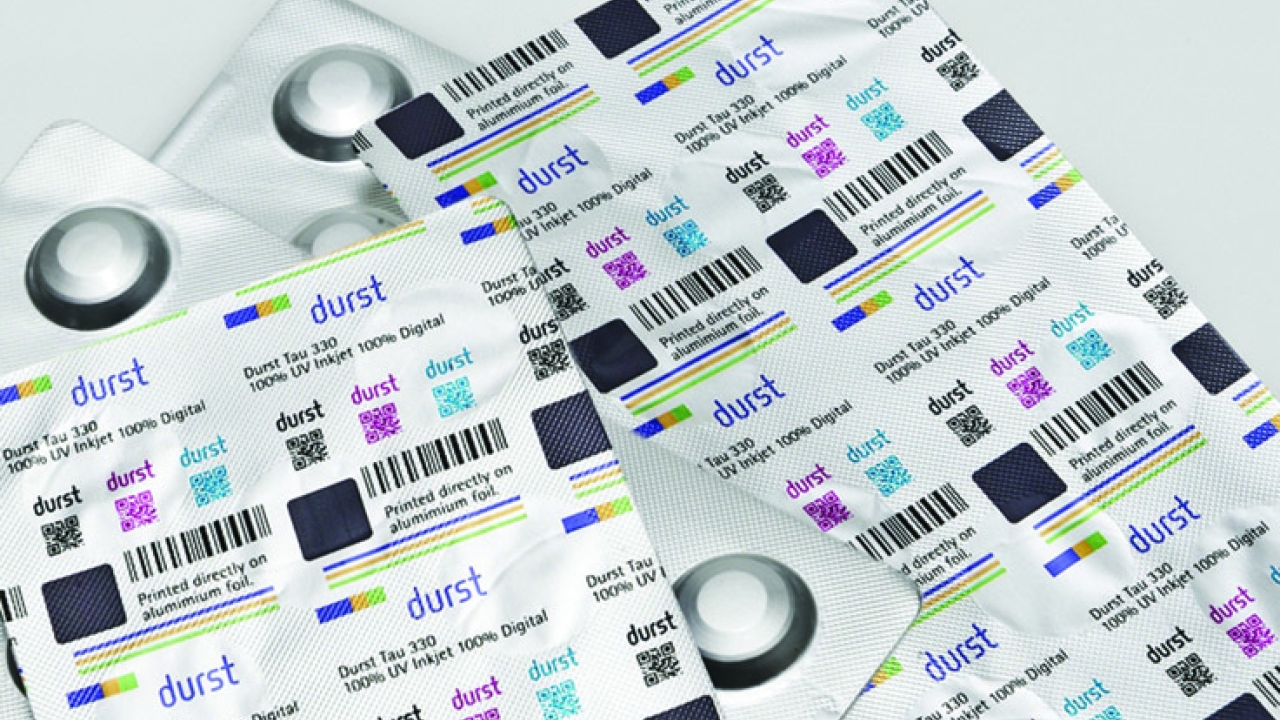Durst expands digital vision

Mike Fairley re-visits Durst in Italy to look at its latest Tau 330 UV inkjet press technology and to assess the company’s progress since its initial entry into the label market in 2009
It’s now a little over three years since Durst Phototechnik, one of the world’s leading manufacturers of high quality digital printing equipment for the large format graphics, pre-press, signage, ceramic tile and décor sectors, corrugated packaging and photographic markets, launched a new option at Labelexpo Europe 2009 for the digital label printing industry. It included prepress workflow software, a high speed single-pass digital UV inkjet label press with variable data printing capability and a modular design off-line converting and finishing unit − all dedicated to the special requirements of short-run digital label production.
The Tau 150 digital UV inkjet label press was available in web widths from 100 mm/ four inches to a maximum of 152 mm/ six inches and capable of a throughput speed close to 50 m/min. (~160 ft./min.). Three years on, how has Durst progressed and where does the company’s UV inkjet technology stand in the label market?
Like many entrants with new label technology, the early days after the Tau press was launched were not without some early challenges. Nevertheless the first press was installed in a label plant in June 2010, followed by a further nine presses in the first trading year. In addition, five presses were installed in the décor market.
In early 2011, production was temporarily halted to enable the company to consolidate and make sure that all the early converter customer machines were working well and that production output and quality was as promised. Satisfied that all was well, sales re-commenced at Labelexpo Europe 2011.
Indeed, the total installed international base of Durst UV inkjet label presses after the first two years had already reached some 20 machines – five in North America, four in Asia, and the rest in Europe. In addition, the entire production output for 2012 has also already now been sold. Quite impressive sales figures for a press technology only launched in late 2009, and which undoubtedly puts them into the top three of UV inkjet label press manufacturers with an installed base in the narrow web label sector.
Looking at the installed base to date, key end-user market applications that the Durst presses are printing for include the pharmaceutical market, household, body care, industrial, automotive and durable labels. New applications being targeted also include aluminum foil blister packs for the pharma market.
While the initial Tau press sales and installations were of the Tau 150, with web widths under 152mm (six inches), press sales and installations today are of the wider width Durst Tau 330 (launched at Labelexpo Americas 2012), which is available in two print widths: the Tau 330 with a print width of up to 330mm (13in), and the Tau 330/200 with a reduced print width of up to 200mm (8in). The Tau’s printing resolution with variable drop size and grayscale technology that delivers an apparent resolution of over 1000 dpi, provides nearly photographic image quality with clean text, smooth vignette gradients and good solid colors.
Durst’s CEO, Dr Richard Piock, explained to Labels & Labeling: ‘Beside our well recognized white ink with very high opacity and the two additional process colors for high pantone color coverage, the new Tau 330 with its greatly expanded print width offers very high size flexibility and at the same time an industry-leading production capacity, two additional and important features which will be a source of competitive advantage for our future customers.
A standard color configuration of CMYK, combined with an optional orange and violet, plus one of the best one-pass high opacity white inkjet inks on the market, enables Durst to offer up to 90 percent coverage of the Pantone color gamut, depending on the substrate being printed. The UV inkjet technology also prints on most substrates without pre-treating.
Durst inkjet inks are very durable, offer a high degree of light fastness and scratch and chemical resistance, so reducing the need for post-press varnishing, coating or laminating.
Durable UV inks are especially important for label converters who often need to supply product identification labels as UL / cUL recognized components for labeling of consumer electronic equipment, cellular communication equipment, garden equipment power tools, etc. where in all cases the label identification system must be durable for the lifetime of the product. The Durst Tau UV inks combined with 3M substrate combinations jointly carry PGJI2 recognition, simplifying the UL recognition process for converters who currently need to maintain their own ink registrations with UL for many of the traditional press ink applications.
New developments also include metallic inkjet inks. Already developed to an acceptable quality and performance, the special Durst inks are continuing to be developed to further enhance the impact of inkjet-printed metallic images without the need for foiling. ‘Indeed,’ says Helmuth Munter, segment manager, Label Printing at Durst, ‘We currently invest around eight or nine percent of our turnover in R&D each year and have a major inkjet research center in Lienz, Austria. We have been a world leader in wide web inkjet printing since 2001. We also regularly test all the main inkjet print heads on the market to ensure that the Durst presses use the best heads available. Currently Durst uses Xaar print heads in the Tau press as these allow the jetting of Durst’s very high opacity white inkjet ink.’
The Tau 330 is equipped with RIP software powered by EskoArtwork with built-in substrate calibration and color management to ensure high image quality and consistency. An electronic job ticket contains all relevant data needed to drive the system. Incoming files are ripped, color management applied and ‘ready-to-print files automatically sent to the queue manager of the press. Jobs can even be re-arranged in the printing queue if the priority changes.
An optional Variable Data Printing (VIP) module with 'insetter' functionality to print on pre-die-cut or pre-printed labels, enables full label-to-label variability as well as 'late stage versioning' applications at the highest printing speeds of the Tau press.
Also shown for the first time at Labelexpo 2012, was a high-resolution Video Inspection System from Nikka that was a built-into the press. This system automatically detects print defects while printing, thus increasing print quality, reliability and production security. The Nikka inspection system uses algorithms specially developed for inkjet printing to detect typical defects like clogged or deviated nozzles, misalignment, color change, broken or missing print, ink spots and streaks.
Applets can be added to measure delta E color difference and inspect according to ISO 15416 grade barcodes and 2D codes. The camera optics of the inspection system adapt to practically all types of paper and film substrates. The inspection option for Tau 330 is available in two packages. The basic inspection includes print quality inspection, PDF verification, detection of nozzle defects, color register and deviation measurement in Delta E. The variable data package adds functions to decode and grade variable bar codes and 2D codes, OCR functions and integration with variable data database.
‘Labelexpo shows have marked our press entries into the label industry over the past three years’, Dr Piock added. ‘However, it should be remembered that Durst is a 70 year old family owned company and throughout our history we have shown a strong and continued commitment to our customers. These product launch are still only the beginning of what we have in-store for the label industry.’
Headquartered in Brixen, Italy, Durst operates manufacturing facilities in Brixen and Lienz, Austria; has major offices in the US, France, United Kingdom, Germany, Canada and Mexico; and partners with exclusive agents worldwide. This extensive network ensures a global support and service network for Durst label industry customers, with key service personnel located in all the subsidiaries. Remote diagnostics, an on-board troubleshooting manual and good customer operator training all help to ensure reliability of operation.
As one of the key leaders in digital inkjet label printing today, and with a rapidly growing installed base of presses – including the recently launched Tau 330 – it seems clear that Durst will undoubtedly have a major impact on the label industry of tomorrow.
Pictured: New market applications for the Tau 330 now include aluminum foil blister packs for the pharma market
This article was published in Labels & Labeling issue 6, 2012
Stay up to date
Subscribe to the free Label News newsletter and receive the latest content every week. We'll never share your email address.


